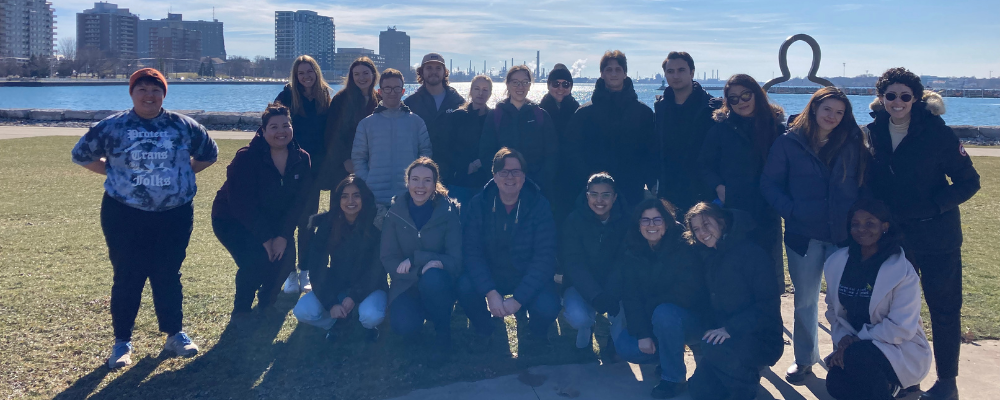Toxic Tour of Chemical Valley illustrates the impact of environmental injustice on Indigenous and working-class communities
April 03, 2024

Many of Professor Wade Wright’s family members and friends work in or near Sarnia’s Chemical Valley, one of Canada’s worst pollution hotspots. Having grown up near Sarnia and worked briefly in Chemical Valley himself during university, he’s no stranger to the environmental and health hazards caused by the region’s many petrochemical factories and refineries.
These hazards hit close to home for Wright at a fairly young age, as various Chemical Valley employees he knew, including members of his own family, experienced cancer and other health issues. It wasn’t until later in life, however, that he would come to better appreciate the disproportionate impacts of pollution on members of the Aamjiwnaang First Nation, located directly in the middle of Chemical Valley.
Now, as the professor for Current Issues in Public Law, Wright took the opportunity to bring his students to experience a “Toxic Tour” of Chemical Valley and Aamjiwnaang First Nation, in order to bring to life the units in the course on the Environment, Climate Change and the Constitution of Canada, and on Indigenous Peoples and the Constitution of Canada. The tour, led by Aamjiwnaang community members, activists and siblings Vanessa and Beze Grey, enables participants to see firsthand the impacts of environmental pollution on their community at the hands of over 60 high-emitting chemical and oil refineries.
“The ‘Toxic Tour’ field trip provided crucial real-life examples to complement the readings on the impact of environmental racism on the Aamjiwnaang First Nation in Sarnia,” said 3L student Brooke Granovsky. “Seeing joggers run past active petrochemical factories, listening to accounts of unreported chemical spills, and discovering that children nickname smokestacks as ‘cloud-makers’ vividly illustrated Sarnia as an ‘unimagined community’ whose welfare is not fully considered in the national discourse on climate change.”
The trip facilitated an experiential lesson on environmental injustice, a theory that identifies and critiques the unequal distribution of environmental harms such as pollution and climate change. The theory details that these harms disproportionately impact poor, racialized and other equity-deserving populations, including Indigenous Peoples in Canada. Beyond this lesson, Wright emphasizes the importance of future lawyers developing awareness of and sensitivity to Indigenous legal issues.
“As future lawyers, our law students have a distinct responsibility to help address Canada’s legacy of harm to Indigenous Peoples, and to play a part in the ongoing project of reconciliation,” said Wright. “As future lawyers, our students may be involved with Indigenous communities, directly or indirectly, and therefore it is essential that they have training in intercultural competency, the history of Indigenous-Crown relations, and Aboriginal and Indigenous law.”
With the stench of chemicals in the air, the students learned of the striking impacts of airborne toxins and spills on the Aamjiwnaang First Nation, as well as working-class Sarnia residents and industry workers. These impacts are all too real for the Aamjiwnaang First Nation, which has higher rates of asthma, cancer, miscarriages, stillbirths and other adverse conditions.
While harm to the Aamjiwnaang First Nation persists, activists like the Grey siblings continue to fight for awareness and legal protections for their community through avenues like the “Toxic Tour.” For students, Wright explains that the tour was an important opportunity to understand how the law has allowed and facilitated these environmental harms to Indigenous communities, and how the law – including the Constitution of Canada – may be utilized to address them.
“Doing a ‘Toxic Tour’ of Aamjiwnaang First Nation and Chemical Valley gave me a real-world example of how the solutions we discuss in the classroom with legal practitioners can lead to actual short and long-term change in communities,” said 3L student Pooja Patel. “It also gave me a glimpse into how activists and lawyers can work together, combining legal knowledge with lived experience, to create social change, which I hope to further as I begin my legal career.”






